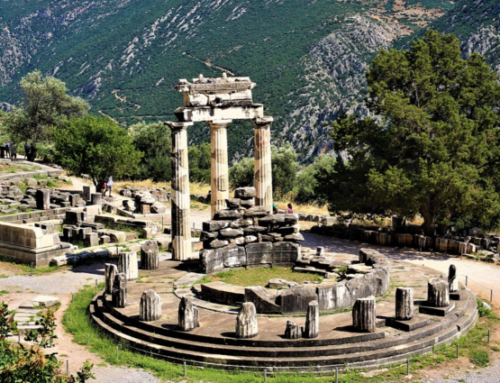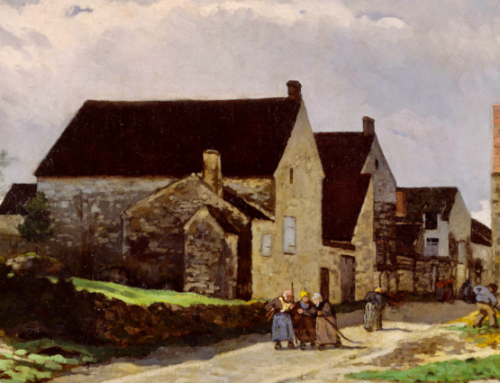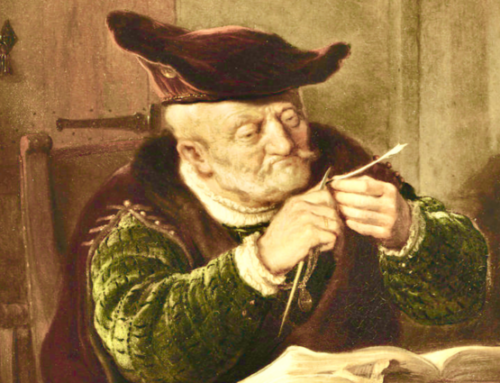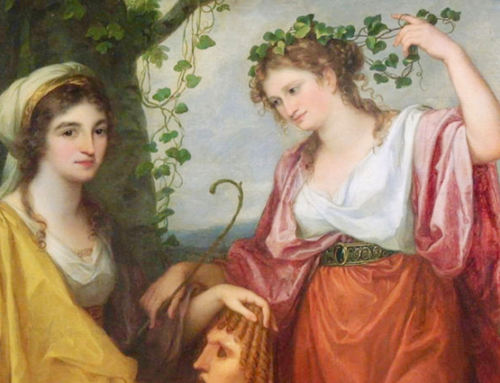Art can be a sort of sacrament of the visible, effecting in itself the transfiguration of the world, and manifesting this to transform our attentive senses, hearts, and minds…
 Art, like philosophy, begins with wonder. Nothing is so surprising as that things exist. Henri Matisse wrote: “One must know how to maintain childhood’s freshness upon contact with objects, to preserve its naivety. One must be a child all one’s life even while a man, take one’s strength from the existence of objects—and not have imagination cut off by the existence of objects.”[1] The current resurgence of representational art can benefit from attention to this wondrous mystery of existence.
Art, like philosophy, begins with wonder. Nothing is so surprising as that things exist. Henri Matisse wrote: “One must know how to maintain childhood’s freshness upon contact with objects, to preserve its naivety. One must be a child all one’s life even while a man, take one’s strength from the existence of objects—and not have imagination cut off by the existence of objects.”[1] The current resurgence of representational art can benefit from attention to this wondrous mystery of existence.
The masters did not take existence for granted. The oldest known art, found in the Chauvet caves, shows a feeling for rhythmic form, expressing structure, life, and movement in a way that anticipates Leonardo da Vinci. Prehistoric artists as well as renaissance and modern masters perceived with wonder the mystery ignored by many sophisticates today, and about which Saint Paul told the Romans: “The invisible things of [God] from the creation of the world are clearly seen, being understood by the things that are made, even his eternal power (δύναμις, dynamism) and Godhead (θειότης).”[2] Great visual art has its basis in this theophany.
The expression of existence in art, as in nature, depends on form. No material thing exists without form. As Etienne Gilson succinctly states, “the word ‘form’ designates the essential nature of a thing or, still more precisely, that nature itself considered as determining the thing in its species and, by the same token, in its figure and in its shape.” [3] Form determines the essence or nature of a thing; and at the same time it is through its form that a thing receives existence (as Boethius observed), because existence is always that of some actually existing thing, and a thing is what it is by virtue of its form. So form causes a thing to be, to be what it is, and to be beautiful (formosus, “full of form”), for beauty is the splendor of being. The splendor of the fullness of form is called claritas or radiance by Saint Thomas Aquinas.
At the core of every thing is the dazzling mystery of its being, the dynamism that keeps it in existence. Existence is an act. The word exist is a verb. Art reveals the splendor, the superabundance of being, the mysterious gushing forth of the act of existing. Thomas Aquinas said that being, entity, reality, is the first and proper object of understanding, because an object is knowable only to the degree in which it is actual.[4] Likewise we may say that the act of existence is the first and proper object of art. An artist takes what is called secondary matter, matter which exists in nature and already has some form—as paint, clay, stone, or some other material—and infuses pictorial or plastic form to create a pictorial or sculptural being, having the act of existence as a work of art. The artist must so inform his matter, must so dispose the masses, lines, shapes and tones, that the resulting work of art is in act.
How can a static object, such as a painted canvas or a sculpted stone, be in act? It happens by virtue of rhythms—rhythmic relations of lines, of shapes, of volumes, or of tones. These rhythms generate a perception of movement. Pictorial form and perception of movement are inseparable. As the painter and theorist Hans Hofmann observed, “A represented form that does not owe its existence to a perception of movement is not a form, because it is… spiritless and inert.”[5]
 Let us look at Chardin’s Fruit, Jug and a Glass, in the National Gallery of Art in Washington. The cork at lower left, surmounted by the white reflection in the water glass, anchors the composition. The right edge of the white reflection makes a sharp diagonal, pulling upward to the right where its forceful movement slows and expands to become the red-orange light on the jug. The opposite, shaded side of the jug presents a firm vertical edge, the bottom of which is kissed by the cool gray of the background just before it swells out and gives birth to the warm, shaded, background peach and the foreground plums. The rounded rhythms of the plums give rise to another diagonal movement up and to the right, moving through the rainbow from green to blue to purple to red, orange, and finally yellow, with a crescendo of light in the burgeoning peaches.
Let us look at Chardin’s Fruit, Jug and a Glass, in the National Gallery of Art in Washington. The cork at lower left, surmounted by the white reflection in the water glass, anchors the composition. The right edge of the white reflection makes a sharp diagonal, pulling upward to the right where its forceful movement slows and expands to become the red-orange light on the jug. The opposite, shaded side of the jug presents a firm vertical edge, the bottom of which is kissed by the cool gray of the background just before it swells out and gives birth to the warm, shaded, background peach and the foreground plums. The rounded rhythms of the plums give rise to another diagonal movement up and to the right, moving through the rainbow from green to blue to purple to red, orange, and finally yellow, with a crescendo of light in the burgeoning peaches.
Chardin’s painting is expansive. The splendor of being radiates from the painting as a whole and from the coordinated actions of each of its parts. Chardin gets inside everything in his painting to make every object exist from the inside out. He feels the dynamism in nature which maintains things in being from within, the pulse of existence. The process by which he creates his work is a participation in the triumphant thrust, continually renewed, by which each and every being in nature achieves existence. As another great painter, Andre Derain, says: “It is not a matter of reproducing an object but, in the ancient sense of the word, the virtue of the object.”[6] Nothing in the painting looks as if it were imposed from outside; every object exists spontaneously, freely, having its vital principle within. Each form is ceaselessly renewed from within by virtue of the rhythm of its contours, the pressure of its tone against those contours, and the precise registering of tonal relations inside and outside the form. In the very structure of a masterpiece like Chardin’s we see an analogue to the mystery of the divine conservation of nature as described by Thomas Aquinas, Moses Maimonides, Ibn Sina, Ramanuja, and other theistic philosophers. Nothing exists unless God, who is Being itself, acts within it, as the wellspring of being, at every moment. There is no such thing as inertia of being. Penetrating this mystery, Chardin’s art gives birth to forms whose presence is ceaselessly renewed by a continuous pulse.
Inseparable from the artist’s task of making things exist from within is the challenge of achieving space on a flat surface. Our experience of space in the world is largely kinesthetic, depending upon the sensation of our bodies’ movement, our feeling of the forces of gravity and equilibrium, and the ever-varying correlation between optical stimuli and eye movements—including binocular convergence, accommodation to focal distance, and parallax. An arbitrary “snapshot,” however, presents a purely optical impression, a jumble of variously shaped tones removed from their spatial context. From being accustomed to viewing such flat images, we develop a “space blindness.” The eye seizes upon recognizable details and, by a conventional sort of leap of credulity, accepts the flat image as referring to things one has experienced in the world. The difference between flatness and space collapses.
The opposite happens in great paintings. There our experience of space is heightened. In a masterpiece by Rembrandt or Raphael, Vermeer or Picasso, for example, a feeling of depth is created by the pushing and pulling of shapes and colors. All the lines and tones are organized, at once musically and architectonically, in such a way as to give the viewer a path or paths of movement into and out of depth; and this depth is made palpable by the tension between it and the flatness of the picture’s surface. The real experience of space in a painting is not quantitative, dependent upon the suggestion of deep vistas; rather, it is qualitative, dependent upon the resonance of the tension between the flat plane and all the pushing and pulling planes of color. The difference between flatness and space is not collapsed in painting; it is amplified.
 In Cezanne’s Mont Sainte Victoire, in the Metropolitan Museum, a powerful tension between the lone central tree straining right and the group of trees tilting left stretches open the space into which the road winds obliquely. The road leads our eye from lower right to upper left, where the mountain pushes up against the sky. The similarity of tone between the mountain and the sky allows our eye to pass easily from one to the other. The sky appears much lighter, however, on the right side of the solitary tree’s crown of foliage. Because the mountain bulges against the sky on the left, the sky has to expand downward on the right side of the painting, as a luminous force pressing down upon the dark earth to cause a concave contour in the latter. (Think of a balloon: If you press on one side [the left side of the sky], the other side [of the sky] has to expand.) The foliage crowning the lone tree gets swept down diagonally with this movement of air. Meanwhile, the aqueduct gathers momentum as it travels from the right edge of the canvas, gaining size, brightness and definition until it punches past the lone tree trunk and terminates in a clump of foliage as in a boxing glove. Ostensibly the foliage belongs to the foreground tree, of course, and not to the aqueduct; but Cezanne has (perhaps unwittingly) left us a clue to its function in the structure by not painting any branch connecting it to the tree! The interaction of distant aqueduct and foreground tree is a violent shock. As always in great painting, near and far planes interact. All the forces are choreographed and balanced. A complete spatial tour is given, replete with pushing and pulling movements that hold near and far planes and volumes in a tense equilibrium. The artist’s experience of the total space within the painting while he is creating it, and the experience of anyone who really perceives the painting fully, is very much like the experience that an athlete, an acrobat, or a dancer has of his or her own body in action.
In Cezanne’s Mont Sainte Victoire, in the Metropolitan Museum, a powerful tension between the lone central tree straining right and the group of trees tilting left stretches open the space into which the road winds obliquely. The road leads our eye from lower right to upper left, where the mountain pushes up against the sky. The similarity of tone between the mountain and the sky allows our eye to pass easily from one to the other. The sky appears much lighter, however, on the right side of the solitary tree’s crown of foliage. Because the mountain bulges against the sky on the left, the sky has to expand downward on the right side of the painting, as a luminous force pressing down upon the dark earth to cause a concave contour in the latter. (Think of a balloon: If you press on one side [the left side of the sky], the other side [of the sky] has to expand.) The foliage crowning the lone tree gets swept down diagonally with this movement of air. Meanwhile, the aqueduct gathers momentum as it travels from the right edge of the canvas, gaining size, brightness and definition until it punches past the lone tree trunk and terminates in a clump of foliage as in a boxing glove. Ostensibly the foliage belongs to the foreground tree, of course, and not to the aqueduct; but Cezanne has (perhaps unwittingly) left us a clue to its function in the structure by not painting any branch connecting it to the tree! The interaction of distant aqueduct and foreground tree is a violent shock. As always in great painting, near and far planes interact. All the forces are choreographed and balanced. A complete spatial tour is given, replete with pushing and pulling movements that hold near and far planes and volumes in a tense equilibrium. The artist’s experience of the total space within the painting while he is creating it, and the experience of anyone who really perceives the painting fully, is very much like the experience that an athlete, an acrobat, or a dancer has of his or her own body in action.
In a masterpiece, every shape, every line, every nuance and every note of color, occurs at just the right time and place in the organic unfolding of the whole. Likewise, Saint Paul tells us that “all things work together for good to them that love God.”[7] The providential choreography of the pictorial elements in a great painting is not simply copied from nature, but is transposed to the canvas as experienced by the artist internally, according to the painter’s own kinesthetic sensibility. The painter must feel the pressures, the weights, the pushes and pulls of pictorial forces, in all their interrelations, as forces within his own body, as if the work of art were the artist’s own body; he must know and feel his work from the inside. This identification with the work is a kind of love, which is why Matisse could state that love is the origin of all creation. A merely objective observation and recording of appearances would miss this necessary quality. A painting is a masterpiece insofar as all things in it work together for good—for beauty, for the harmonious and radiant unfolding of the whole. A painting is produced from, and manifests, a personal and individual relation to the forces of nature, of reality—to providence, if you will.
Artists must cultivate this sensibility, just as Christians must cultivate the love of God in order to see all things working together for good. The casual sightseer in Provence is no more likely to see the interactions and interdependencies between distance and foreground, among mountain, trees, and aqueduct, which Cezanne registers in the Mont Sainte Victoire, than is the casual observer of events in the world to see everything working together for good. Yet both Saint Paul and Paul Cezanne try to awaken us to transformed vision—and transforming action.
In prayer, one can find the internal place where one’s own contingent being depends upon the continual creative action of God, and one can abide there, not escaping from corporeality but experiencing the divine energy within one’s body. Various spiritual traditions, such as the hesychast tradition in Eastern Christianity, foster body-centered prayer, a rooting of the act and the state of prayer in God’s presence and action within the heart, which is within the body. God is both outside us—all around us—and within us. The eye is the lamp of the body. One’s way of looking at reality either lets God’s light in or keeps it out. The heart which is transformed, permeated by divine light, in turn sends light to all the rest of the body, so that the whole body participates in transfiguration (μεταμόρφωσις, metamorphosis, in the New Testament).[8] Because we are bodily creatures this does not occur ethereally; it takes place through our breathing, our heartbeat and circulation, our speaking and acting in the world; it involves movement. The transforming of matter and of vision is also the aim of art, and here too it is centered in our bodily experience; it is kinesthetic.
 When a work of art has formal integrity, it unfolds organically within itself, and this unfolding within the work is continuous with an unfolding of the work toward the viewer, the way the work has of showing forth itself from itself, the act of being present which constitutes the picture plane as an event which transcends the physical dimensions of the canvas. A painting on a small surface—for example, Van Eyck’s Arnolfini Wedding Portrait in the National Gallery in London (left)—can have a rhythmic vitality, a plenitude of existence, a splendor of being so expansive as to illuminate a beholder standing at a distance. It has more bigness than any billboard! The work possesses expansiveness, radiance, claritas.
When a work of art has formal integrity, it unfolds organically within itself, and this unfolding within the work is continuous with an unfolding of the work toward the viewer, the way the work has of showing forth itself from itself, the act of being present which constitutes the picture plane as an event which transcends the physical dimensions of the canvas. A painting on a small surface—for example, Van Eyck’s Arnolfini Wedding Portrait in the National Gallery in London (left)—can have a rhythmic vitality, a plenitude of existence, a splendor of being so expansive as to illuminate a beholder standing at a distance. It has more bigness than any billboard! The work possesses expansiveness, radiance, claritas.
This clarity is not a function of bright colors or sharp details. One can easily find paintings which have brighter hues than the Van Eyck, or sharper details than the Chardin or Cezanne, but which lack clarity, which have little presence, appearing confused and muddled even from a short distance, collapsing in on themselves instead of expanding. Clarity is a radiant intelligibility resulting from a plenitude of form. Paucity of form results in lack of clarity, no matter how brilliant the pigments or tight the rendering. The expansiveness of a masterpiece arouses in the heart of the wakeful observer a reciprocal unfolding, an expansion or ecstasy. Goodness is diffusive of itself.
Traditional art stands worlds apart from the attempt (often called ‘realism’) to copy the external appearances of things without magnifying the divine power (δύναμις) which creates and sustains them, or the divine wisdom which orders them—as if they were “just there.” Carried to an extreme, such “realism” (a late nineteenth-century innovation, foreign to the old masters) results in lifeless effigies, superficial and frozen, and is blasphemous despite the artists’ intentions.
Kinesthesis is the key to Chardin and all the old masters. The modern masters sought to revive this tradition, which had become quite attenuated by the end of the nineteenth century as painters took to emulating photography. It is very difficult to combine skillful rendering with kinesthetic form as the old masters did; by the end of the nineteenth century it seemed to be a vanishing art—largely because the culture had forsaken the metaphysical vision which supported it. Artists were tending more and more to render “photographically,” without metaphysical depth. In reaction to this trend the modern masters simplified and sacrificed rendering, while at the same time distorting contours in their pursuit of movement and space.
 Whereas Chardin’s still life presents no obvious distortions, because Chardin changes the shapes of things in a subtle way, by means of light and shade, Matisse (who revered Chardin), simplifies the pictorial grammar, eliminating shading. Therefore, like Lucas Cranach, Persian miniaturists or Russian iconographers—all of whom suppress shadow—he must distort contours in order to accomplish the same thing Chardin achieves: space and volume, the evocation of the act of existence.
Whereas Chardin’s still life presents no obvious distortions, because Chardin changes the shapes of things in a subtle way, by means of light and shade, Matisse (who revered Chardin), simplifies the pictorial grammar, eliminating shading. Therefore, like Lucas Cranach, Persian miniaturists or Russian iconographers—all of whom suppress shadow—he must distort contours in order to accomplish the same thing Chardin achieves: space and volume, the evocation of the act of existence.
In Matisse’s Still Life with Ivy (right), the blue saucer swells toward the right while the lip of the cup strains leftward, and the white underside of the saucer dips down to the right to balance the magnetic pull of the blue paper bearing the head in white contours in the upper left. The white pitcher “deforms” to balance itself within this magnetic field, and also to hold its relation to both the leftward pull of the white plate and the bow-and-arrow configuration of the fruit—which is aimed at the pitcher’s handle. There is a reason for every line and spot of color in this masterpiece being exactly where it is in relation to everything else.
Matisse and Picasso are unabashed in their distortions, but for that very reason their works, rightly perceived, provide a key: They show us, undisguised, what representation has always required. If their lesson is ignored, the otherwise commendable attempt to revive traditional art risks mimicking the comparatively shallow art of the late nineteenth-century academy, which had itself lost touch with the tradition of the old masters, just as the surrounding culture had lost the metaphysical sense of things, embracing a mechanistic vision.
 The distortions of figures and objects in the works of Matisse and Picasso demonstrably serve their pictures’ volume, space, and movement. Their distortions are different in degree, but not in kind, from those found in such old masters as Leonardo, Michelangelo, Raphael, Rubens, Titian, and Durer, and they serve the same purpose. Consider for example Titian’s Venus and Adonis (left) in the Metropolitan Museum. Venus’ right thigh is much too long; a realistic rendering would not show any of that thigh, because the pelvis would hide it. Titian shows us the knee too far to the left in order to create a pinwheel of limbs which whirls clockwise until it meets Adonis’ advancing leg. The distortion makes the form kinesthetic, and simultaneously conveys the movement of Ovid’s story, as Adonis leaves his lover’s grasp. Thus it is similar to opera or ballet. Average viewers are not aware of such distortions, nor should they be. They are disguised by the skillful rendering, and in this instance by the white cloth draped from the shoulder to the knee. When Picasso displaces limbs, on the other hand, he does not disguise the fact. But neither Picasso nor Titian paints “realistically” in the sense of copying appearances. Neither does Cezanne, Chardin, or Van Eyck.
The distortions of figures and objects in the works of Matisse and Picasso demonstrably serve their pictures’ volume, space, and movement. Their distortions are different in degree, but not in kind, from those found in such old masters as Leonardo, Michelangelo, Raphael, Rubens, Titian, and Durer, and they serve the same purpose. Consider for example Titian’s Venus and Adonis (left) in the Metropolitan Museum. Venus’ right thigh is much too long; a realistic rendering would not show any of that thigh, because the pelvis would hide it. Titian shows us the knee too far to the left in order to create a pinwheel of limbs which whirls clockwise until it meets Adonis’ advancing leg. The distortion makes the form kinesthetic, and simultaneously conveys the movement of Ovid’s story, as Adonis leaves his lover’s grasp. Thus it is similar to opera or ballet. Average viewers are not aware of such distortions, nor should they be. They are disguised by the skillful rendering, and in this instance by the white cloth draped from the shoulder to the knee. When Picasso displaces limbs, on the other hand, he does not disguise the fact. But neither Picasso nor Titian paints “realistically” in the sense of copying appearances. Neither does Cezanne, Chardin, or Van Eyck.
Picasso famously shows us too many views of a head at once. The old masters often did likewise, to serve the kinesthetics of form. Below is an example by Ingres, a detail from his Bather in the Musee Bonnat. The kerchief suggests a partial back view of the head. The ear is held in tension with the acute angle of shadow between kerchief and neck, while the other features pull “too” far away to the left. Finally Ingres shows us the far eye socket wrapping around toward us. The head unfolds across the canvas like a world map in Mercator projection.
 In traditional art, representation is thoroughly “abstract” in the sense that every line, shape, volume or tone, every nuance, must be rhythmically choreographed with every other. The strength of the representation is due to the abstract rhythmic structure. The reason for this, as we have shown, is the crucial link between artistic form and metaphysical form. As the painter Jean Bazaine puts it:
In traditional art, representation is thoroughly “abstract” in the sense that every line, shape, volume or tone, every nuance, must be rhythmically choreographed with every other. The strength of the representation is due to the abstract rhythmic structure. The reason for this, as we have shown, is the crucial link between artistic form and metaphysical form. As the painter Jean Bazaine puts it:
It seems therefore necessary that we should once and for all dissociate the ‘abstract’ from the ‘nonfigurative.’ The power of interiority, and of getting beyond the visible, which creation implies, does not depend upon the greater or smaller degree of resemblance between the work and external reality, but, rather, upon the greater or smaller degree of resemblance with an internal world that entirely envelops the external one and that expands itself up to the pure rhythmical motives of being…. Van Eyck may well represent the most extreme point ever reached by abstraction in the whole history of painting. [9]
Usually the soul is said to be interior to the body. But in the case of a saint or a masterpiece (both signs of a transfigured cosmos), the body is interior to the soul. The internal world entirely envelops the external one. The world, simultaneously internal and external, springs into existence from God’s creative act, an ongoing, sustaining and providential act. “In Him we live, and move, and have our being.” [10] Art is true to nature, and enlarges us with its beauty, when it draws strength and freshness from contact with this mystery. Art can be a sort of sacrament of the visible, effecting in itself the transfiguration of the world which it signals, and manifesting this to transform our attentive senses, hearts, and minds. For art to thrive, the public ought to be taught how to see and appreciate the deep workings of form in masterpieces, while artists strive to recover the perennial and universal tradition.
The Imaginative Conservative applies the principle of appreciation to the discussion of culture and politics—we approach dialogue with magnanimity rather than with mere civility. Will you help us remain a refreshing oasis in the increasingly contentious arena of modern discourse? Please consider donating now.
Notes:
[1] Jack D. Flam, Matisse on Art (New York, 1978), 148.
[2] Romans 1.19-20. KJV
[3] Etienne Gilson, Painting and Reality (New York, Bollingen Foundation, 1957), 110.
[4] Summa Theologica Ia, q.5, a.2.
[5] Hans Hofmann, quoted in Seitz, William C., Hans Hofmann, (New York, Museum of Modern Art, 1963), 39.
[6] George Hilaire, Derain (Geneva, Pierre Caillier, 1959), 52.
[7] Romans 8.28. KJV
[8] See Matthew 17:2, Mark 9:2, Romans 12:2, 2 Corinthians 3:18.
[9] Notes sur la peinture, pp. 56-57, quoted by Etienne Gilson, op. cit., 259.
[10] Acts 17:28 KJV







So beautiful, this article, and with a profound consideration given to the Soul’s ever loving and transformative agency in art.